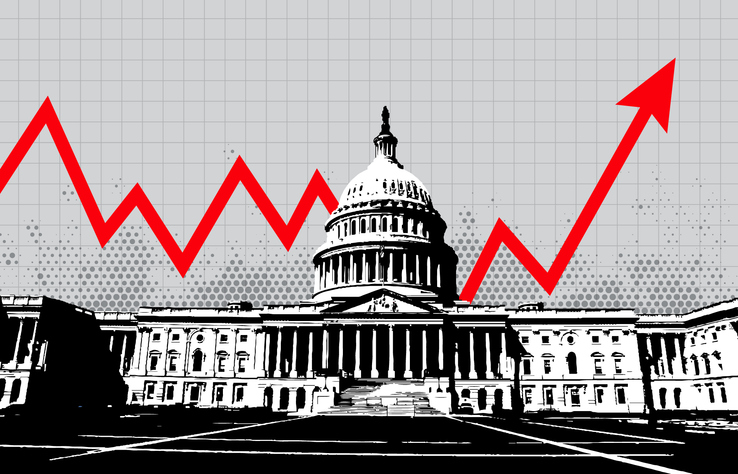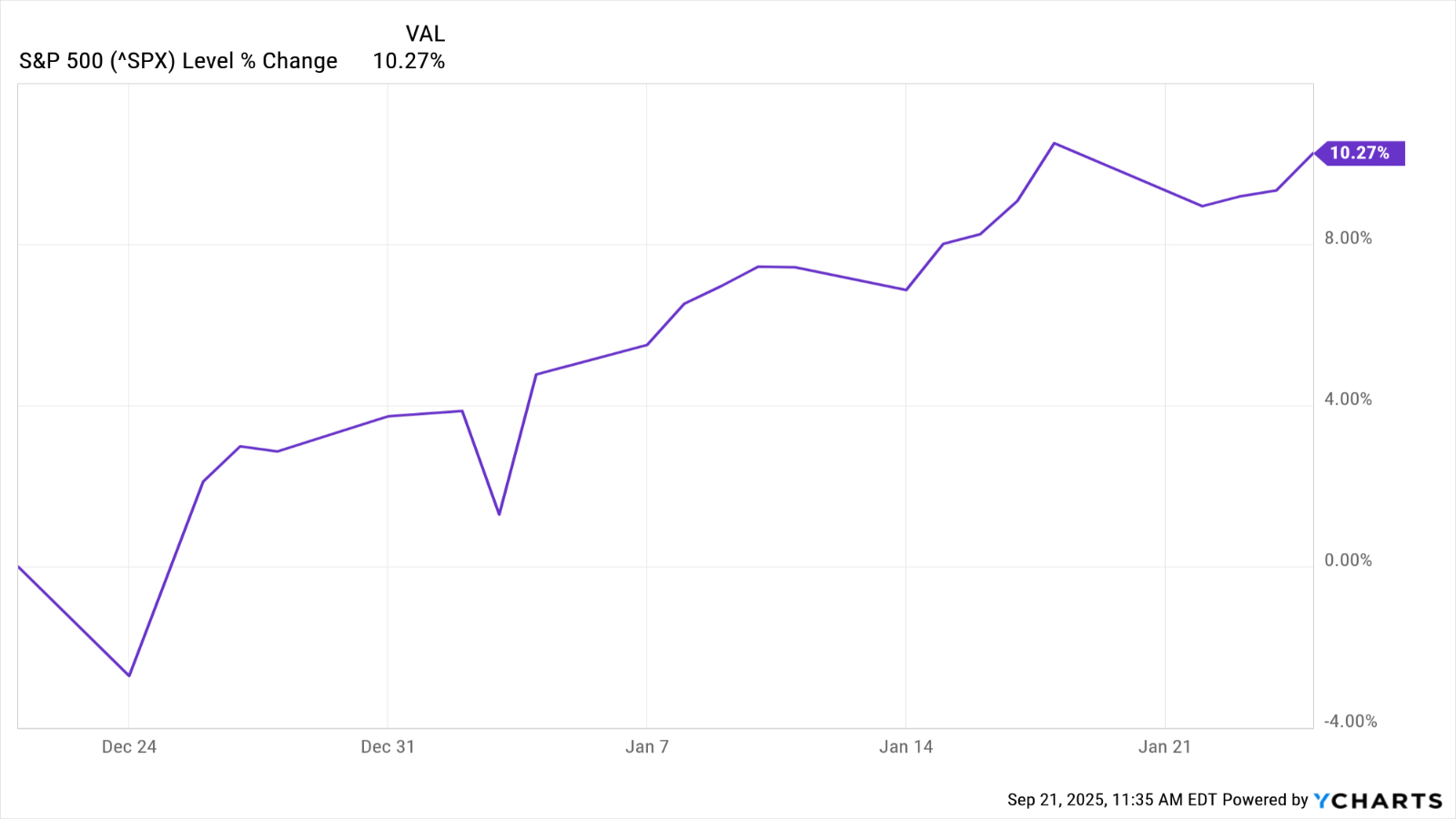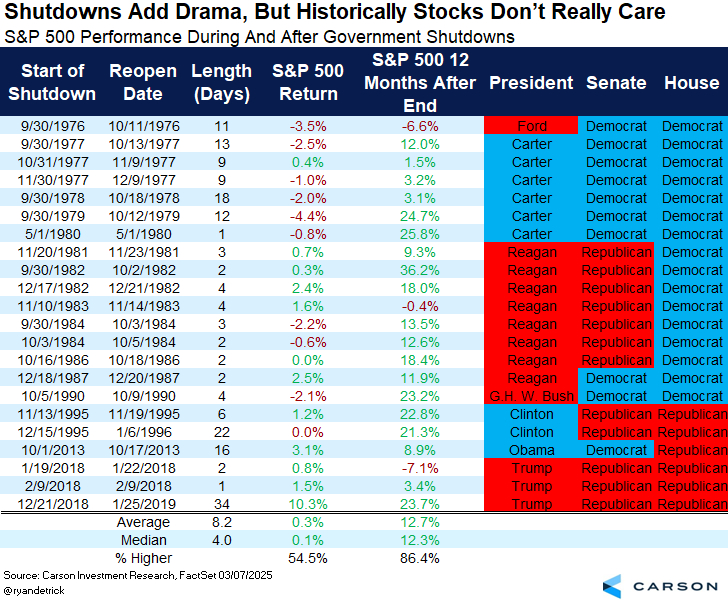What Does a Government Shutdown Mean for Stocks?
A federal government shutdown doesn't spell doom for stocks.


Federal government shutdowns aren't bad for stocks, at least historically speaking.
Although the market hates the threat of a federal government shutdown, the S&P 500's performance during past shutdowns has been pretty good.
If our latest government shutdown, which went into effect at 12:01 am Eastern Daylight Time on October 1, seems particularly irksome, it might be because markets are trading at record levels — and rich valuations — despite the effects of tariffs, sticky inflation and a softer labor market. No one wants dysfunction in Washington to mess with success.
From just $107.88 $24.99 for Kiplinger Personal Finance
Become a smarter, better informed investor. Subscribe from just $107.88 $24.99, plus get up to 4 Special Issues

Sign up for Kiplinger’s Free Newsletters
Profit and prosper with the best of expert advice on investing, taxes, retirement, personal finance and more - straight to your e-mail.
Profit and prosper with the best of expert advice - straight to your e-mail.
September is historically the worst month for stocks. Yet, the market didn't get the memo this year. The S&P 500 finished September up 3.7% on a total return basis (price change plus dividends), continuing its remarkable 33% rally off the April low.
The Federal Reserve's rate cut — and forecasts for additional reductions later this year and in 2026 — are boosting the bull market, as is optimism in the upcoming earnings season.
Stock performance during government shutdowns
Happily, for market participants, the historical record for stocks when the federal government shuts down is far from one of doom and gloom.
There have been 22 government shutdowns since 1976, not including this one, but on only four occasions were operations affected for more than one business day, writes Jeffrey Buchbinder, chief equity strategist at LPL Financial. That leaves us with only four "true" shutdowns, Buchbinder notes, the last occurring in late 2018 into early 2019.
It's tough to remember now, but the S&P 500 returned 10.3% during the 35-day shutdown of 2018-2019. Have a look at the chart below:

Stocks did fine during the extended shutdown of October 2013, too.
"Historically, markets were not materially impacted by a shutdown," Buchbinder says. "For example, in 2013, the government was shut down for 16 days during the first part of October. The S&P 500 had some down days but overall, the equity market took all the political drama in stride with a 3.1% advance during those 16 days."
It's sort of counterintuitive, but in past government shutdowns, the S&P 500 rose 55% of the time, generating an average return of 0.3%, according to data from Carson Group.
Even better, 12 months after the end of the shutdown, the S&P 500 was higher 86% of the time, with an average return of 12.7%.

"The good news is history says shutdowns have little to no effect on stocks," writes Carson Group Chief Market Strategist Ryan Detrick. "Most shutdowns last only a few days, so just enough to get in the headlines, and then it is over just as quickly."
Past performance is no guarantee of future results, but the record for stocks in government shutdowns is almost encouraging.
When the last federal government shutdown ended in 2019, the S&P 500 went on to return almost 24% in the next 12 months. There are probably plenty of market participants who would take that deal again.
Related content
- How Social Security Would Be Affected By A Government Shutdown
- What A Government Shutdown Means For Student Loan Payments
- A Government Shutdown Could Disrupt Your Travel Plans — Eventually
- How Medicare Would Be Affected By A Government Shutdown
- Government Shutdown to Delay Data, Including Key Jobs Report
Profit and prosper with the best of Kiplinger's advice on investing, taxes, retirement, personal finance and much more. Delivered daily. Enter your email in the box and click Sign Me Up.

Dan Burrows is Kiplinger's senior investing writer, having joined the publication full time in 2016.
A long-time financial journalist, Dan is a veteran of MarketWatch, CBS MoneyWatch, SmartMoney, InvestorPlace, DailyFinance and other tier 1 national publications. He has written for The Wall Street Journal, Bloomberg and Consumer Reports and his stories have appeared in the New York Daily News, the San Jose Mercury News and Investor's Business Daily, among many other outlets. As a senior writer at AOL's DailyFinance, Dan reported market news from the floor of the New York Stock Exchange.
Once upon a time – before his days as a financial reporter and assistant financial editor at legendary fashion trade paper Women's Wear Daily – Dan worked for Spy magazine, scribbled away at Time Inc. and contributed to Maxim magazine back when lad mags were a thing. He's also written for Esquire magazine's Dubious Achievements Awards.
In his current role at Kiplinger, Dan writes about markets and macroeconomics.
Dan holds a bachelor's degree from Oberlin College and a master's degree from Columbia University.
Disclosure: Dan does not trade individual stocks or securities. He is eternally long the U.S equity market, primarily through tax-advantaged accounts.
-
 Don't Wait Until January: Your Year-End Health Checklist to Kickstart 2026
Don't Wait Until January: Your Year-End Health Checklist to Kickstart 2026Skip the fleeting resolutions and start the new year with a proactive plan to optimize your longevity, cognitive health, and social vitality.
-
 Premium Rewards Cards: More Perks, Higher Fees
Premium Rewards Cards: More Perks, Higher FeesSome issuers are hiking the annual fee on their flagship luxury credit cards by hundreds of dollars. Are they still worth using?
-
 3 Trips to Escape the Winter Doldrums, Including An Epic Cruise
3 Trips to Escape the Winter Doldrums, Including An Epic CruiseThree winter vacation ideas to suit different types of travelers.
-
 How to Master the Retirement Income Trinity: Cash Flow, Longevity Risk and Tax Efficiency
How to Master the Retirement Income Trinity: Cash Flow, Longevity Risk and Tax EfficiencyRetirement income planning is essential for your peace of mind — it can help you maintain your lifestyle and ease your worries that you'll run out of money.
-
 I'm an Insurance Expert: Sure, There's Always Tomorrow to Report Your Claim, But Procrastination Could Cost You
I'm an Insurance Expert: Sure, There's Always Tomorrow to Report Your Claim, But Procrastination Could Cost YouThe longer you wait to file an insurance claim, the bigger the problem could get — and the more leverage you're giving your insurer to deny it.
-
 Could a Cash Balance Plan Be Your Key to a Wealthy Retirement?
Could a Cash Balance Plan Be Your Key to a Wealthy Retirement?Cash balance plans have plenty of benefits for small-business owners. For starters, they can supercharge retirement savings and slash taxes. Should you opt in?
-
 Changes Are Coming for This Invesco Bond Fund
Changes Are Coming for This Invesco Bond FundThe Invesco BulletShares 2026 Corporate Bond ETF's bonds will mature in 2026. Here's what investors should do.
-
 7 Retirement Planning Trends in 2025: What They Mean for Your Wealth in 2026
7 Retirement Planning Trends in 2025: What They Mean for Your Wealth in 2026From government shutdowns to market swings, the past 12 months have been nothing if not eventful. The key trends can help you improve your own financial plan.
-
 What Defines Wealth: Soul or Silver? Good King Wenceslas' Enduring Legacy in the Snow
What Defines Wealth: Soul or Silver? Good King Wenceslas' Enduring Legacy in the SnowThe tale of Good King Wenceslas shows that true wealth is built through generosity, relationships and the courage to act kindly no matter what.
-
 An Investing Pro's 5 Moves to Help Ensure 2025's Banner Year in the Markets Continues to Work Hard for You in 2026
An Investing Pro's 5 Moves to Help Ensure 2025's Banner Year in the Markets Continues to Work Hard for You in 2026After a strong 2025 in the stock market, be strategic by rebalancing, re-investing with a clear purpose and keeping a disciplined focus on your long-term goals.
-
 The Santa Claus Rally Officially Begins: Stock Market Today
The Santa Claus Rally Officially Begins: Stock Market TodayThe Santa Claus Rally is officially on as of Wednesday's closing bell, and initial returns are positive.